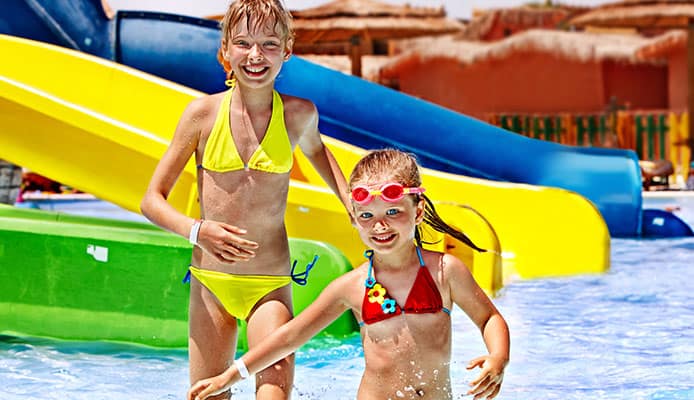
Pool slides make an awesome addition to any pool, translating to hours of fun and enjoyment for kids and the young at heart. Although it may seem like a straightforward endeavor, there are actually several things to consider before installing a pool slide.
1. Type of Pool
The first thing you need to consider before installing a pool slide is the type of pool that you have. This is because some pools just aren’t designed to accommodate this pool feature. For instance, an infinity pool evokes an image of sophistication and tranquility, and putting a brightly-colored pool slide with lots of twists and turns will simply look out of place.
Then there’s the issue between in-ground pools and above ground pools. A lot of pool slides are designed for in-ground pools and are required to be permanently mounted on concrete. There are available pool slides for above-ground pools, but their installation requirements are quite different since they need to be mounted on a wooden deck which is less sturdy than a concrete base. That said, you’ll want to first talk to an experienced contractor to determine if the deck and surrounding of your above-ground pool can accommodate a pool slide to avoid potential safety hazards.
2. Space and Location
Another important thing to consider is where to install the pool slide and how much space is available for it. Different types and styles of pool slides will require different amounts of space beyond the ladder to the bottom and tip of the slide. If you don’t provide ample decking around the slide, it may hamper accessibility and you’ll have to walk around the pool or under the slide to reach the ladder.
Besides, consider installing the slide at the deep end of the pool facing the patio or seating area. This way, you can keep an eye on the kids while they’re climbing up and going down the slide.
3. Safety Regulations
A key factor to consider when installing pool slides is safety. Some places have laws in effect which determine what type, size, and design of slide can be installed in residential swimming pools. Make sure that you are aware of these regulations to avoid confrontations with the authorities later on.
Aside from that, there are basic safety guidelines that you should follow when it comes to installing a pool slide. For instance, you’ll have to make sure that the ladder going up the slide have treads in them to reduce slipping. Non-slippery handrails are also a must. You also need to make sure that the slide is positioned in such a way that the slide’s exit is considerably far from the pool wall and that the water is deep enough for a safe landing.
4. Budget
How much a pool slide will cost depends on a variety of factors. As you may have already known, pool slides come in a wide array of shapes and sizes, and these two factors alone almost often dictate the price. Suffice to say that if you want to have the best pool slide installed in your pool, then be ready to spend at least a few thousand dollars or more. Also, don’t forget to factor in the assembly and installation costs for the pool slide.
5. Style and Design
If you go online, you’d see that there are quite a handful of pool slide designs available, from pre-fabricated slides to custom-made slides and everything else in between. There are pool slides that look like the old fashioned slides you see in playgrounds and parks. There are also pool slides that have one or several twists and turns which makes for a more exciting ride.
Pool slides are also available in different colors, although white and blue remain to be the most popular choices. Also, pool slide manufacturers now offer slides with varying textures, some of which mimic natural elements like a stone for instance.
In any case, be sure that you choose a slide design that will work with the overall appeal you want for your backyard pool. Depending on your personal needs and requirements, different pool slide designs can work for your pool.
6. Slide Size and Height
There are many things to consider when it comes to choosing the size and height of your pool slide. In most cases, the available space around your pool will be a key factor that will influence your decision. However, if you are still in the process of building your pool, then it will be easier for you to incorporate your desired pool slide size and height in the construction.
Pool slide height can fall anywhere between 4 to 14 feet give or take. When choosing the height for your pool slide, consider those who will be using it the most – your kids. Tall slides may be intimidating for little children and prevent them from even using them.
Also, choose a pool slide with a wide flume or slide and preferably with deep walls on its sides. This is a much safer option and will even help to encourage kids to enjoy using the slide since they no longer have to be afraid of falling over as they go whizzing down the slide.
7. Slide Material
Most pool slides nowadays are made from either fiberglass Gelcoat or rotationally molded polyethylene plastic. Some manufacturers still make use of acrylic in producing their products, but not many pool owners patronize slides made from this material because their colors fade easily after being exposed to the sun.
The first two materials mentioned are worth looking into if you’re shopping for a new pool slide. They are strong, durable, and resistant to corrosion and chemicals. They are also quite beautiful and can maintain their colors much better than acrylic pool slides.
8. Running Water
Running water is necessary to make the slide more slippery and avoid bruising or scratching your back and bottom. There are two basic options available for pool slides in residential properties: a hose connected to the house’s water lines or a water line connected to the pool’s water circulation system.
Both options are effective in creating a slippery surface for the pool. But the first option is much cheaper and is recommended for homeowners who don’t use their pool (and consequently the slide) regularly.
In contrast, a hose that is connected to the pool’s circulation system will cost more and is suitable for pool slides that are used often and for longer periods of time. A note when using this system: be sure to monitor your pool’s water levels because they can drop quite a bit especially during hot days.
9. Contractor
Considering the hazards of an improperly constructed and installed pool slide, this is one project that is best left in the hands of an experienced contractor. Many things go into the installation of a pool slide like drainage, structural support, and even aesthetic finishing.
If you are still in the process of building a swimming pool in your backyard, you should talk to the contractor and ask them to work with your landscape architect. This way, you can be sure that your pool slide will complement the rest of the landscape instead of looking out of place.
You might also like: Best Pool Toys
10. Maintenance
Many pool owners spend a considerable amount of time keeping their pools clean. However, they often neglect to take care of their pool slides. The reasons as to why may vary from one person to another, but the result is the same: the slide becomes wobbly and discolored or unsightly. Screws and bolts will become loose and will need to be tightened from time to time. Glazing and polishing will also be necessary to maintain the smooth finish of the pool slide. If you are planning to install a pool slide, allot some of your time in maintaining it or at least consider hiring someone to do this for you.
Globo Surf Overview
Installing a pool slide may just be one of the better investments you’ll make for the pool and home. It allows your kids and guests to have more fun aside from just soaking in the pool. Still, there are certain things to consider before installing a pool slide, and keeping these in mind will help to ensure that you have a slide that will put smiles on your family’s faces for many years to come.


